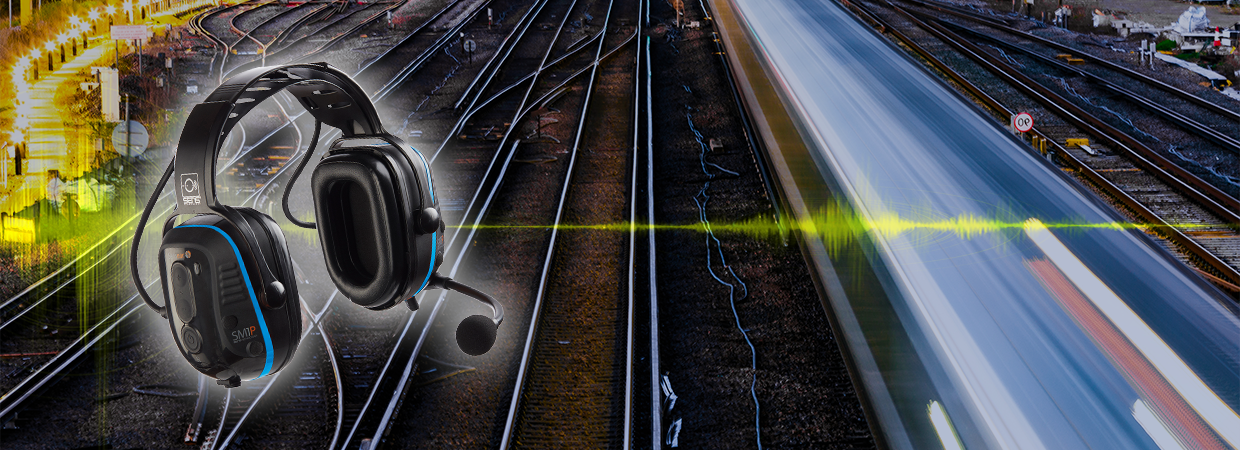- Home
- Blog
- Noise Suppression
- How Do Noise Suppression Headsets Work?

Industrial noise suppression headsets are different from standard noise reduction muffs as well as active noise-canceling headphones, the latter of which are often used on public transportation or within offices when you want to cancel out background noise and listen to music.
However, in many industrial work environments, where safety is paramount, standard noise reduction muffs and active noise-canceling headphones are not the best solutions, because workers may not be able to communicate or hear safety calls or audio alarms being activated. Workers lose situational awareness of their surroundings and have difficulty communicating with others, which can create hazards in many work environments.
In these scenarios, it’s best to use digital noise suppression headsets with speech enhancement technology, which allows you to hear speech and emergency calls, while suppressing excessive background noise to a safe level, such as the sounds coming from heavy equipment, machinery, and even explosions or gunshots.
How Noise Reduction Works
Noise reduction is achieved by reducing the ability of sound waves to enter the ear either with earmuffs or earplugs typically made with high-density foam to filter and reduce noise.
How Active Noise Cancellation Works
Active noise cancellation works by canceling out the lower-frequency sounds of background noise.
They do this by picking up ambient sound from the outer shell of the headset and creating an analog waveform that is negative or opposite to the noise, thereby canceling it out
The Definition of Noise Cancellation
Noise cancellation is all about eliminating the unwanted noises in your surrounding environment.
Active noise-canceling headphones are more advanced because they create their own sound waves to further cancel out almost all background noise. They do this through the use of built-in microphones to monitor sounds in the surrounding environment.
Digital Noise Suppression vs. Active Noise-Canceling
Digital noise suppression headsets use real-time digital processing to determine the noise of the surrounding environment and suppress the noise to a safe level. It does this via 1 to 4 external microphones that sample the external environment for noise. Typically the more microphones on the exterior of the headset the better the ability to suppress the background noise and the better the headset's ability to provide 3D sound or directional audio to the speakers in the ear cups. This directional audio is important to workers in high noise environments as it allows them to be able to tell from which direction the noise is coming from.
Active noise-canceling headphones also have a built-in microphone on the exterior to pick up ambient noise in order to cancel it out. They use noise-canceling circuitry, which creates an analog sound wave opposite of the noise being picked up by the external microphone, which almost completely cancels it out, getting rid of most of the exterior noises including those that you may actually want to hear.
Both noise suppression and active noise-canceling have electronic circuitry which requires power to function and are typically powered by an internal battery.
SENS® Technology – How It Works
Sensear Headsets use SENS® Technology, meaning it lowers the level of unwanted ambient sounds through Active Noise Control (ANC) technology while enhancing important environmental sounds, such as speech.
This is vital in an industrial workplace where employees need to be constantly vigilant of their surroundings for safety.
SENS® Technology works by isolating and enhancing speech while simultaneously lowering the audio level of excessive background noise to a safe level.
This means workers can continue to communicate with one another while being aware of their environment and reducing the effects of harmful excessive noise.
SENS® Technology - The Benefits
SENS® Technology has many benefits, including the ability to be able to communicate face-to-face with workers close by while keeping the headset on.
The headsets also connect to two-way radios and some have Bluetooth® and built-in short-range for headset-to-headset communication. Meaning employees can keep communication open when they are on the factory floor, in the mine, on an oil rig, or in other loud noise work environments.
SENS® Technology adapts to changes in background noises quickly, keeping workers protected from excessive noise produced by machinery such as compressors, pumps, heavy vehicles, and explosions. Sensear headsets are also certified to a maximum output of 82dB to the ear in noise up to 110dB. The output level is programmable and can be increased or decreased depending on your specific requirements.
HEAR SPEECH (WITHOUT CLIPPING) IN ANY NOISE:
- Intermittent - workshop, machinery, heavy vehicles
- Continuous - compressor, motors, pumps
- Impact - hammer, gunshot, explosion
MAINTAIN 360° SITUATIONAL AWARENESS AND DETERMINE NATURE, DISTANCE, AND DIRECTIONALITY OF ALL SOUNDS INCLUDING:
- Speech
- Machinery/Vehicles
- Alarms
Sensear's SENS® Technology headsets also work with hearing aids, for workers suffering from previous hearing loss. It will enhance their sounds so they can still easily hear surrounding speech and other important sounds while giving them protection from further loss of hearing.
Choosing the right industrial headset can be a head-spinning challenge. With so many products on the market claiming to offer so many different benefits, the process can quickly become overwhelming. Here’s a free download guide on how to choose the best headsets for your industry, your needs, and your environment ...








